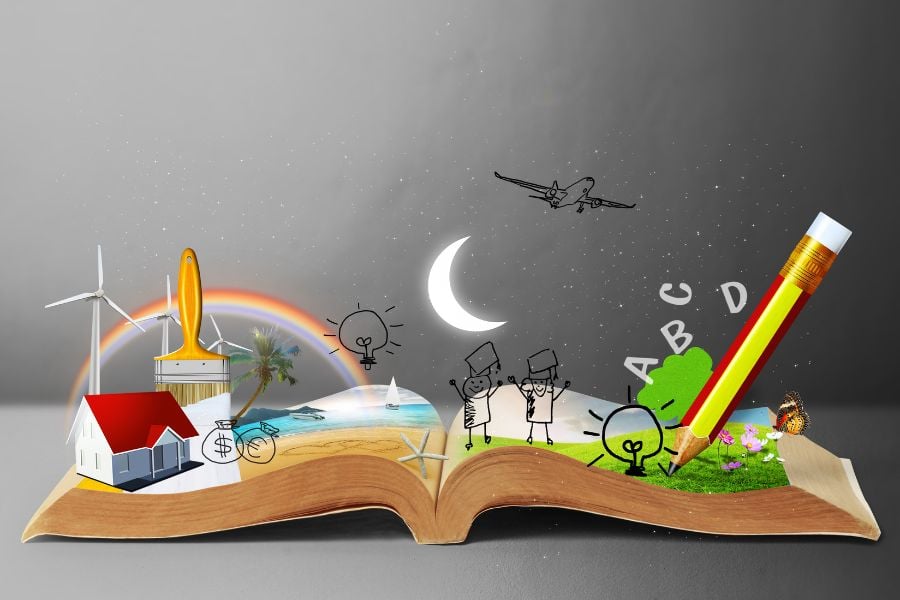Do you find yourself using word circumlocution in your writing without understanding its use?
You “beat around the bush” by using an euphemism when writing about a topic you are uncomfortable with and you don’t want to offend your readers.
You use evasion in your writing because you feel that will keep your readers on your page.
However, you struggle with keeping your readers engaged.
Your sentences are too long, confusing, and your readers want you to get to the point.
This is circumlocution, a deliberate attempt at an indirect way of writing and speaking that is common in the United States and other world cultures.
And our post will help you understand how to use wordiness with this literary device effectively.
We will explore examples from film and literature, touch on when you should use circumlocution, and dive into activities to help you practice.
Let’s begin!

Circumlocution Examples From Speech and Writing
In speaking and good writing, you can find examples of how circumlocution is used to express ideas more creatively.
Figurative Circumlocution
This form of circumlocution involves using figurative language, such as metaphors and similes. It’s often used to make language more colorful, interesting, or impressive. For example:
- “The lady of the house” instead of using “my mother” or “my wife”.
- “The city that never sleeps” instead of “Las Vegas”.
- “The fairer sex” instead of “women”.
- “The unconventional or less popular choice” instead of “the path less travelled by”.
- “The land down under” instead of “Australia”.
- “The man in the moon” instead of “the moon”.
- “The place where the sun rises” instead of “the east”.
- “The one who holds the scepter” instead of “the king”.
- “The land of opportunity” instead of “America”.
- “The big apple” instead of “New York City”.
Figurative circumlocution is one form of creative expression. But so is evasive circumlocution, which is often used to avoid unpleasant situations.
Evasive Circumlocution
This form of circumlocution is often used in situations where a person doesn’t want to give a straight answer. It could be embarrassing or incriminating. For example:
- “That’s a great question. I think it’s something we should all consider more deeply” instead of saying “I don’t know”.
- “Mistakes were made” instead of saying “I made a mistake”.
- “That’s an interesting topic, but have you considered…” instead of answering a personal question.
- “I think we may have to disagree on that point” instead of saying “you’re wrong”.
- “What’s really important is that we focus on the future and how we can improve society” instead of answering a difficult question.
- “We’re going to be moving in a different direction” instead of saying “we’re firing you”.
- “He passed away” instead of saying “he died”.
- “That’s certainly a unique perspective” instead of “I don’t like your idea”.
- “I ran into some unexpected traffic” instead of “I’m late”.
- “It slipped my mind” instead of “I forgot”.
Now that you have a firm grasp of figurative and evasive circumlocution, let’s look at examples from literature that shows you how effective it can be.
Circumlocution in Literature

Literature that “stands the test of time”, such as the works of Dickens, Shakespeare, and Hemingway, show one feature that is common.
These authors have mastered circumlocution.
Let’s check out these examples:
21. Little Dorrit by Charles Dickens
This novel introduced the Circumlocution Office, a government department.
Here’s a description of how this office functioned:
“In the official cat-and-mouse game of the Circumlocution Office, where no straightforward path led to any destination, the process of getting a simple request fulfilled could turn into an intricate dance of paperwork, endless queries, and convoluted conversations.”
This example expresses the idea that the Circumlocution Office is an ineffective bureaucratic office that avoids taking care of the requests submitted to it.
22. Kubla Khan by Samuel Taylor Coleridge
This poem highlights the importance of direct and suggestive expression in an artistic work. For example, a passage from this poem:
“In Xanadu did Kubla Khan
A stately pleasure-dome decree:
Where Alph, the sacred river, ran
Through caverns measureless to man
Down to a sunless sun.”
This passage describes the location and characteristics of Kubla Khan’s pleasure-dome, which is large and surrounded by walls and towers.
23. Hamlet by William Shakespeare
Circumlocution is used for dramatic effect especially when the characters avoid giving direct answers or speaking in a roundabout way. For example, Polonius’s advice to his son Laertes before he leaves for France:
“Give thy thoughts no tongue, Nor any unproportioned thought his act. Be thou familiar, but by no means vulgar. Those friends thou hast, and their adoption tried, Grapple them unto thy soul with hoops of steel; But do not dull thy palm with entertainment Of each new-hatched, unfledged comrade.”
Polonius is telling Laertes to remain true to his values, beliefs and principles and to not let society dictate who he should be.
24. The Lord of the Rings by J.R.R. Tolkien
Circumlocution is used to elicit a sense of grandeur and mystery. This is used in descriptions of characters, places, or events.
For example, the wizard Gandalf is described as:
“He was tall, and his robes were long and of snowy white; but his head was grey, and his face stern and old, wise and gentle. He wore a tall pointed grey hat, a long grey cloak, and a silver scarf. He had a long white beard and bushy eyebrows that stuck out beyond the brim of his hat.”
25. The Old Man and the Sea by Ernest Hemingway
Circumlocution is found in descriptive language and indirect phrases. For example, this passage describes the old man:
“The old man was handsomely weathered, his face etched with deep lines that told stories of a life spent battling the elements and facing countless challenges on the unforgiving sea. His eyes, like the endless horizon, held the wisdom of a thousand sunsets.”
26. Harry Potter by J.K. Rowling
In this series, Voldemort is often referred as “He-Who-Must-Not-Be-Named” or “You-Know-Who” because the characters are too scared to say his name.
Circumlocution in Pop Culture

You will also find circumlocution examples in pop culture, such as on TV, in the movies, and in the music you listen to:
27. The Simpsons
Ned Flanders often uses indirect and wordy language to maintain his polite and positive demeanor.
For example, he will say:
“Well, that’s just a little bit ungood, neighborino!” instead of saying “that’s bad”.
28. Game of Thrones
The characters often use circumlocution to navigate political and social scenarios.
For example, Littlefinger often says:
“Chaos isn’t a pit. Chaos is a ladder”.
29. Hotel California by The Eagles
In the lyrics to this song is circumlocution.
For example:
“You can check out any time you like, but you can never leave”
Instead of saying that once you’re part of a certain lifestyle, it’s hard to break free.
30. Star Wars
Yoda uses a roundabout way of speaking.
For example, one of his quotes is:
“Do or do not, there is no try,” instead of simply saying, “either you do it or you don’t”.
31. Spider-Man
Peter Parker often says:
“With great power, there must come great responsibility,
Instead of simply saying:
“People with power need to be responsible”
32. Cardigan by Taylor Swift
This song includes the line, “when you are young, they assume you know nothing,” instead of directly saying, “people underestimate the young”.
When You Should Use Circumlocution
There are times when using circumlocution improves your writing skills and there are times when you shouldn’t use it.
Use these recommendations and you will see how much your writing improves:
Vivid and Engaging Writing
Using indirect or figurative language can create striking images and elicit emotions in your readers.
Building Suspense or Interest
By using innuendo and not revealing everything directly, you can build suspense or interest. This can be particularly effective in fiction or creative nonfiction.
Character and Tone Development
In fiction, the way a character uses verbosity can reveal a lot about their personality, background, and feelings.
Politeness and Tact
Circumlocution can be a way of saying something difficult or controversial in a more tactful or polite way.
Evasive Answering
There might be situations, especially in persuasive writing, where it’s beneficial to avoid giving a direct answer.
Circumlocution can help your writing, but you need to know when it can hinder it.
When You Should Avoid Using Circumlocution
A common mistake writers make is misusing locution. This can be one of the reasons why you lose your readers.
Let’s look at how this happens:
Lack of Clarity
The main disadvantage of circumlocution is that it can make your writing less clear. If you’re too indirect by using too many extra words, your readers might not understand what you’re trying to say.
Long-Windedness
Circumlocution can make your writing wordy and long-winded. Prolixity can make it tedious to read and might cause you to lose your readers’ attention or interest.
Lack of Directness
Sometimes, being direct and straightforward is the most effective way to communicate.
Possible Misinterpretation
Because circumlocution often relies on implications, there’s a risk that different readers will interpret your writing in different ways.
Loss of Credibility
If you use circumlocution to evade direct answers or to hide the truth, you might lose your readers’ trust and credibility.
You can overcome the obstacles circumlocution can cause you. There are activities that you can practice that will elevate your writing.
Activities to Practice Circumlocution

If you want to master a skill, you have to be like a student and practice it.
Here are some activities that you can have fun with and they can take your vocabulary and communication skills to the next level:
Wordless Picture Description
Select a picture and try to describe it without using certain obvious words. For example, if you have a picture of a beach, try to describe it without using the words “beach,” “sand,” “water,” “sun,” etc.
Guess the Object
In a group setting, one person selects an object in the room but doesn’t reveal what it is. They then describe the object using circumlocution until the others guess what it is.
Rewriting Sentences
Take a simple straightforward sentence and try to rewrite it using circumlocution. For example, “She is eating an apple” might become “She is indulging in the sweet crunch of red autumn fruit”.
Short Story Challenge
Write a short story where a character has to explain something without directly stating what it is. This can help you practice indirect speech and build suspense or intrigue in your writing.
Charades with Words
This is similar to the classic game of charades, but you’re using verbal clues instead of physical ones. Try to get others to guess a word, phrase, or concept without saying the word itself or other obvious related words.
Dialogue Writing
Write a dialogue between two characters who are being intentionally indirect with each other. This could be a scene where they’re trying to discuss a controversial topic tactfully or a situation where they’re trying to outwit each other.
Synonym Search
Choose a noun, adjective, or verb, and try to describe it using other words. Do this without actually using the word itself.
For example, you can describe the word “laughter” as “the spontaneous sound you make when you find something amusing”.
When you practice these new writing skills, you will find you are becoming more effective in your communication as a writer.
Circumlocution Can Help You Become a More Effective Communicator
Circumlocution can elevate your writing.
It adds variety, interest, and helps you develop a distinct voice.
It helps you create suspense and intrigue in your storytelling.
Plus, it helps you practice diplomacy and tact in tackling controversial topics.
So, take action today and implement what you’ve learned.
You can do this!
Show your audience your circumlocution skills and watch your readers engage with you.
Now “the ball is in your court”.



